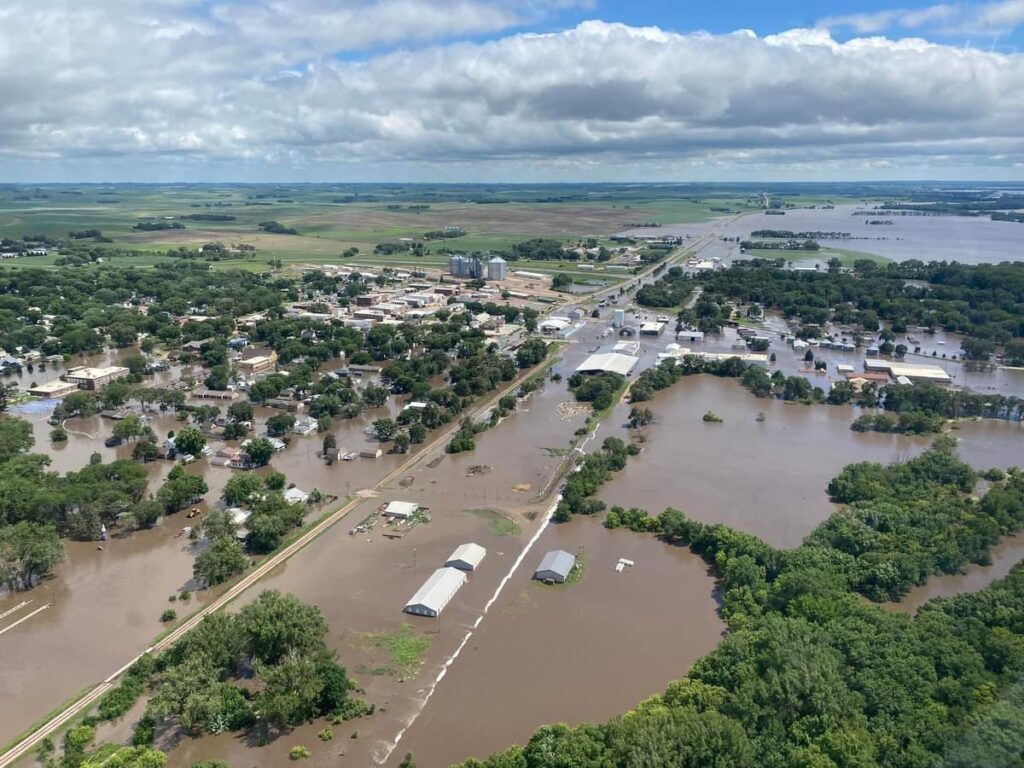Gov. Kim Reynolds and members of her cabinet oversaw northwest Iowa impacted by flooding in a helicopter tour June 21, 2024. (Photo courtesy of Gov. Kim Reynolds’ office)
President Joe Biden has approved a Major Disaster Declaration for flooding in Iowa, allowing federal funding for residents and businesses in areas impacted by recent severe weather.
The expedited declaration follows a request from Gov. Kim Reynolds in response to severe flooding from beginning June 16 in northwest Iowa. Heavy rainfall has caused flooding along the Missouri River and connected waterways, with some areas surpassing river levels from the historic 1993 floods.
In the areas impacted by flooding and severe storms last weekend, Reynolds said at a Sunday news conference that 1,900 properties were affected or destroyed by water damages, and thousands of people were evacuated from flood areas. Iowa Emergency Management Director John Benson said that the total damages and costs remains unknown, but that the impacts of the weekend flooding are “extensive.”
The Federal Emergency Management Agency and U.S. Small Business Administration can now provide aid in Clay, Emmet, Lyon, Plymouth, and Sioux counties with Biden’s declaration. People in these five counties can apply for assistance through FEMA’s Individual Assistance Program for funds for costs of destroyed property as well as expenses for medical and legal services related to the severe weather. Area businesses can apply for low-interest loans through the SBA Disaster Loan Program.
People seeking federal assistance can apply through the FEMA disaster assistance website and the SBA loan portal. Federal assistance for Iowa communities was also approved by Biden in May for areas impacted by tornados.
Additionally, federal funding was made available through FEMA’s Public Assistance Program for state, tribal and local governments, as well as certain nonprofit organizations, for disaster response work such as debris removal and emergency protective measures in Buena Vista, Clay, Dickinson, Emmet, Lyon, O’Brien, Osceola, Plymouth, and Sioux counties. Funding is also available on a cost-sharing basis for hazard mitigation measures statewide, according to FEMA.
The flooding seen by Iowa communities like Rock Valley and Spencer over the weekend were part of a larger trend of major storms that hit the upper Midwest, also impacting areas of South Dakota, Nebraska and Minnesota. At least two people have died due to the extreme weather, including one man in Clay County who attempted to drive through floodwaters. Flooding has also caused the collapse of a bridge on Sunday connecting Sioux City in Iowa with North Sioux City, South Dakota.
Rainfall up to 600% above normal
The Iowa Department of Agriculture and Land Stewardship reported Monday that some stations of northwest and north central Iowa received “several months’ worth of rainfall” — between 300% and 600% above the normal rainfall.
Iowa Secretary of Agriculture Mike Naig said in a statement weather forecasts show a reprieve from rainfall in northwest Iowa, but “those downstream need to be prepared as this water heads south.”
“Our hearts go out to all the Iowans affected by this devastating flooding. We do not yet know the full picture of damage to homes, businesses, farms, crops, livestock, communities and public infrastructure, but we know that it is likely to be substantial and costly,” Naig said. “Iowans are resilient and we will get through this together, but this recovery will certainly take some time and require considerable resources.”
Storms and subsequent flooding have not subsided yet. Another evacuation in the towns of Smithland and Rodney occurred early Tuesday after a levee broke on the Little Sioux River. Additionally, the Iowa Department of Transportation announced it plans to close a portion of Interstate 29 near Council Bluffs and portion of I-680 west of I-29 beginning Tuesday night due to rising flood waters, with timing based on Missouri River water levels and weather patterns.
Governors ask Iowans to stay off Missouri River
As flooding continues along the Missouri River, Reynolds and Nebraska Gov. Jim Pillen released a joint statement Monday urging people to stay off the river until water levels come down.
“Now is not the time to be on the water,” Reynolds and Pillen said in the release. “In addition to higher-than-normal flow, there’s also the potential for more debris in the water, which poses a significant risk to anyone on the Missouri. It’s best to wait until levels return to normal to resume regular activities.”
The National Weather Service has also predicted more heavy rainfall hitting other areas of the state in coming days. Donna Dubberke, meteorologist-in-charge at the Des Moines NWS said Sunday that eastern and central Iowa could see severe weather and flooding in the upcoming week.
The post Biden approves federal aid for Iowa counties impacted by flooding as severe weather continues appeared first on Iowa Capital Dispatch.

